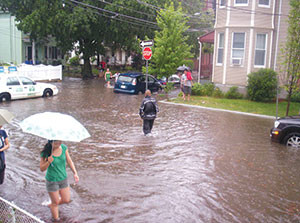
The city is looking at ways of increasing permeable surfaces to the streets of Somerville in hopes of reducing damage caused by flooding in certain neighborhoods.
By Gabriela C. Martinez
On January 15, the Legislative Matters Committee held a meeting that discussed the strengthening of two zoning ordinances designed to increase permeable surfaces in the city.
Both of the ordinances, introduced in 2012, govern pervious surfaces in the city by requiring individuals to include a percentage of pervious surfaces in their construction projects. In addition to including pervious surface, homeowners and businesses must also go through an inspection process that ensures that their construction projects do not increase storm water runoff into neighboring properties.
“I ask that these ordinances go back to the legislative matters committee, so we can make them stronger. We really want to cut down on the amount of surfaces in he city where water can’t seep through,” said Ward 2 Alderman Maryann Heuston.
According to Heuston, Somerville has been subjected to flooding throughout history. Part of the problem has to do with faulty development schemes such as the filling of the Millers River. While most of it was filled, the river still flows underneath many parts of the city. The flooding, Heuston noted, can also be attributed to the city’s antiquated water and sewer system. Like many older cities, Somerville has a combined storm water and sanitary sewage system that does not have the capacity to drain the excess water from rapid downpours.
The city has long acknowledged the problem of having an antiquated drainage system, which is why long-term projects, such as the streetscape and infrastructure improvements that will be included in Union Square’s Revitalization Project, are considered the best solutions. The Cedar Street Sewer Separation Project, which is scheduled to begin this spring, will increase drain capacity and separate the sewer system.
“Any of the infrastructure done in Union Square is going to be an incredible help. And I don’t think that’s going to be five years down the road, because you can’t develop Union Square; you can’t build the buildings that the Master Developer wants to build without the infrastructure.”
In the meantime, routine maintenance of sewer pipes and increasing the amount of pervious surfaces in the city will help mitigate floods on a smaller scale while the substantial infrastructure projects are on their way. In a recent sewer drain line cleaning, sewer maintenance contractors took out “100 years worth of gunk,” which amounted to 220 tons, from the drainage system.
The city’s legislators will continue to tackle Somerville’s ongoing flooding problem from different angles. At their next meeting on January 20, the Flood Forum Special Committee will discuss a directive that requires developers to install backflow regulators in their new projects.















Reader Comments